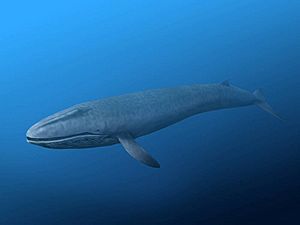Horopeta facts for kids
Quick facts for kids Horopeta |
|
|---|---|
 |
|
| Restoration of Horopeta | |
| Scientific classification |
|
| Kingdom: | Animalia |
| Phylum: | Chordata |
| Class: | Mammalia |
| Order: | Artiodactyla |
| Infraorder: | Cetacea |
| Family: | incertae sedis |
| Genus: | †Horopeta Tsai and Fordyce, 2015 |
| Species | |
|
|
Horopeta was an ancient type of baleen whale. It lived a very long time ago, during the Late Oligocene period. This was about 25 to 27 million years ago! Its fossils were found in a place called the Kokoamu Greensand in New Zealand.
What is Horopeta?
Scientists can tell Horopeta apart from other ancient whales by looking closely at its skull. For example, the bones at the top of its head had a special shape. Also, some of its ear bones were unique. These small differences help scientists identify Horopeta fossils.
How Scientists Classify Horopeta
Scientists use special methods to figure out where ancient animals fit into the family tree of life. When they first studied Horopeta, they thought it might be an early type of whale called a balaenomorph or a cetotheriid.
Later studies helped confirm that Horopeta was an early kind of baleen whale. It was not part of the group of modern baleen whales we see today.
What Horopeta Ate
Based on the shape of its jaw, Horopeta was one of the first ancient whales that could "gulp-feed." This is how many modern baleen whales eat. They open their mouths wide to take in huge amounts of water and small prey, then filter the water out.
The same rocks where Horopeta fossils were found also contained other amazing ancient sea creatures. These include early odontocetes (toothed whales) like Awamokoa, Austrosqualodon, Otekaikea, and Waipatia. There were also other ancient baleen whales like Matapanui, Tohoraata, Tokarahia, Waharoa, Mauicetus, and Whakakai.

